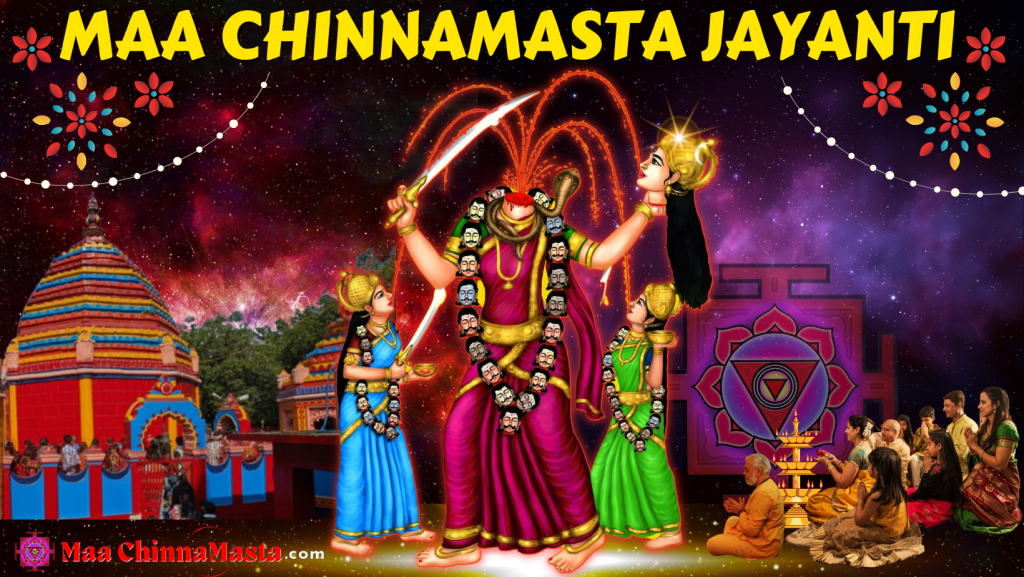MAA CHINNAMASTA JAYANTI

This year, Maa ChinnaMasta Jayanti will be celebrated on May 4, Thursday.
Significance Of Maa ChinnaMasta Jayanti
Maa ChinnaMasta Jayanti is an auspicious festival celebrated annually on shukla paksha chaturdashi of baisakh month as per the lunar calendar by the ardent devotees and worshippers Of Maa ChinnaMasta, The Divine Mother Of Self-Sacrifice And Altruism, The Life-Giver And The Life-Taker.
Origin Stories And Legends Of Maa ChinnaMasta
The story Of The Emergence Of Maa Chhinnamasta appears in two distinct sets of legends:
- The Origin Myths Of Dus Maa MahaVidyas
- Stories explaining The Genesis Of Maa Chhinnamasta As An Individual Form Of The Divine Mother.
The Emergence Of Maa ChinnaMasta As One Among The Dus Maa MahaVidyas
In chapter 8 of the tenth century shakta mahabhagavata purana, lord shiva extolled The Glory Of The Dus Maa MahaVidyas to sage narada. Lord shiva also recounted to sage narada the legend Of Emergence Of The Dus Maa MahaVidyas, The Ten Great Cosmic Wisdom Expressions Of The Divine Mother Of the universe.
According to the legend, once Maa Sati, A Form Of The Divine Mother Manifesting As The Daughter Of daksha And First Life-Partner Of lord shiva, Became Enraged When Her father did not invite Her and lord shiva to his fire sacrifice ceremony.
Despite lord shiva’s protests, Maa Sati In Her Anger Insisted On Attending the ceremony To Destroy Her father’s pride. When lord shiva kept on refusing to give Her permission to attend, Maa Sati Decided To Remind lord shiva That She Was The Very Emanation Of The Divine Mother Herself.
With Lips Trembling With Anger And Eyes Blazing like the conflagration of destruction, Maa Sati Roared With Laughter. Terrified lord shiva swiftly fled in all directions. To Restrain him, The Divine Mother Appeared In One Transcendent Form In Each Of the ten directions. In whichever direction lord shiva fled, She Was There Confronting him In One Of Her Ten Maa MahaVidya Forms. To his right (in the east) With The Self-Decapitated Head In Her Hand Stood Maa ChinnaMasta, The Fearsome And Enigmatic Form Of The Divine Mother. Maa Chinnamasta’s Association With the east direction symbolizes auspicious renewal of the process of life and death.
The Emergence Of Maa ChinnaMasta As An Individual Form Of The Divine Mother
In the prana toshini tantra, a compilation of the tantric texts, there is a story Of The Origin Of Maa Chinnamasta from the narada pancharatra.
According to the story, one day Maa Parvati, The Reincarnation Of Maa Sati, Went To Bathe In the mandakini river With Her attendants jaya and vijaya, also known as dakini and varnini. After Bathing, Maa Parvati’s Complexion Turned Black Due To Sexually Arousal. Around that time, Her two attendants begged Her for food out of extreme hunger. They prayed and begged saying, “We are overpowered with hunger, O Mother Of the universe! Give us food so we may be satisfied, O Merciful One, Bestower Of Boons And Fulfiller Of desires.”
On Hearing this sincere prayer of Her devotees, The Merciful Divine Mother Smiled And Severed Her Head With Her Fingernails. As Soon As She Severed Her Head, Her Head Fell On The Palm Of Her Left Hand. Then Three Bloodstreams Emerged From Her Throat; The Left And Right Streams Of Blood Fell Respectively Into the mouths of Her attendants flanking Her on either side, And The Central Bloodstream Fell Into Her Own Mouth. After Her Act Of Self-Sacrifice To Feed Her devotees By Decapitating Her Own Head, Maa Parvati Was Venerated As Maa ChinnaMasta.
In svatantra tantra of prana toshini tantra, lord shiva narrates another similar story Of Maa ChinnaMasta’s Emergence. In the krta yuga, Maa MahaMaya Was Engaged In mahavrata With lord shiva on mt. kailasa. At the time of lord shiva’s seminal emission, The Divine Mother Appeared Fierce And From Her Body two shaktis emerged and became Her attendants dakini and varnini.
One day The Divine Mother went to the bank of the pushpabhadra river With Her two attendants. When it was noon, Her hungry attendants requested The Divine Mother, “Please give us food.” Hearing this, The Smiling And Auspicious Divine Mother Looked In all directions And Severed Her Head. She Fed dakini With The Left Bloodstream Coming Out Of Her Throat, She Fed varnini With The Right Bloodstream, And From The Central One, She Drank Her Own Blood.
After Playing In This Way, She Replaced Her Head On Her Body And Reverted To Her Original Form. At dusk, She Returned Home With Her attendants. This happened on the day Of Viraratri. Thus, according to the story, Maa ChinnaMasta Emerged On Viraratri.
The stories of origin emphasize The Greatness Of Maa ChinnaMasta’s Mercy And The Power Of Self-Sacrifice And Altruism. In addition, The Depiction Of Maa ChinnaMasta Decapitating Herself And Feeding Her attendants And Herself Symbolizes That In Her Divine Play, destruction and creation occur simultaneously, And That She Is All-Pervasive, Yet Remains Beyond all that She Has Created.
Temples Commemorating Maa ChinnaMasta Jayanti
Maa ChinnaMasta Jayanti is celebrated with great festivities by the devotees. On this occasion, devotees decorate the temples and shrines with love and devotion. The devotees and worshippers chant mantras for worship and recite praises Of Maa ChinnaMasta in temples and shrines. In addition, temples arrange community kitchens in which poor people eat good food for free.
Some famous temples for worship Of Maa ChinnaMasta are:
- The temple for worship Of Maa Chintpurni in Himachala Pradesh, Northern India
- The temple in Rajrappa in Jharkhand, India
- A shrine dedicated To Maa ChinnaMasta In The Maa Durga Temple Complex, Ramnagar, near Varanasi, Uttar Pradesh
- A shrine in the Changu Narayan Temple in Changunarayan Municipality of Bhaktapur District, Nepal
- A temple in Patan, Lalitpur Metropolitan City in Nepal
References:
- https://timesofindia.indiatimes.com/religion/festivals/chinnamasta-jayanti-2022-date-story-and-significance/articleshow/91537701.cms
- https://www.republicworld.com/lifestyle/festivals/chhinnamasta-jayanti-history-significance-celebration.html
- https://www.rudraksha-ratna.com/articles/chinnamasta-jayanti#:~:text=In%20the%20upcoming%20year%2C%20Chinnamasta,May%204%2C%202023%2C%20Thursday.
- Anne, B. E. (1994). Chinnamasta: the Aweful Buddhist and Hindu Tantric Goddess.
- http://timesofindia.indiatimes.com/articleshow/91537701.cms?utm_source=contentofinterest&utm_medium=text&utm_campaign=cppst
- https://en.wikipedia.org/wiki/Chhinnamasta#Temples

